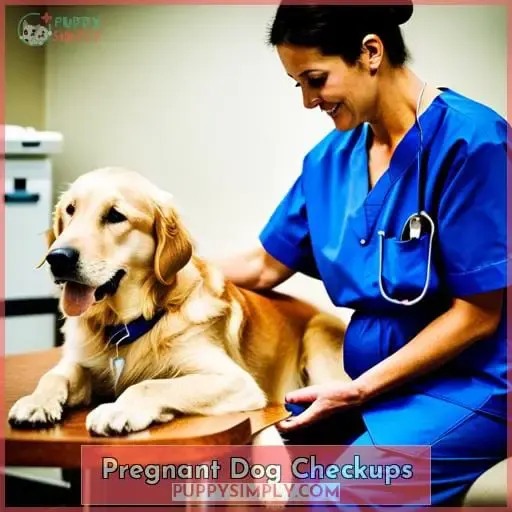This site is supported by our readers. We may earn a commission, at no cost to you, if you purchase through links.
 Visualize your pup happily bounding about, full of youthful energy.
Visualize your pup happily bounding about, full of youthful energy.
To keep their tail wagging for years, bring them to the vet regularly—from puppyhood through their senior years—for checkups, vaccinations, and preventative care.
Doing so empowers you to protect their health, understand indicators when something’s amiss, and potentially detect diseases early when they’re most treatable.
Table Of Contents
- Key Takeaways
- Puppy Checkups
- Adult Dog Checkups
- Senior Dog Checkups
- Pregnant Dog Checkups
- Immediate Vet Attention
- Pet Insurance Coverage
- What Does Pet Insurance Cover?
- How Does Pet Insurance Work?
- How Much Does Pet Insurance Cost?
- Ensuring Optimal Pet Care
- Frequently Asked Questions (FAQs)
- Are there any specific vaccines or treatments that my dog might need based on its breed or location?
- How do I know if my senior dog is experiencing chronic pain and when should I seek veterinary care?
- What are some common signs of poisoning in dogs and how should I handle it?
- What does a comprehensive physical examination for dogs typically include?
- How can I prevent obesity and dental issues in my adult dog?
- Conclusion
Key Takeaways
- Puppy checkups should include initial checkups within 2 weeks of bringing them home, follow-up visits at 6-8 weeks for vaccinations and preventive treatments, and additional booster shot appointments at 12 and 16 weeks.
- Adult dogs should continue to receive vaccinations every 1-3 years for core vaccines, and annual wellness checks are important to catch any unfamiliar changes early.
- Senior dogs should have biannual wellness checks every 6 months, with additional tests such as blood work or X-rays to establish baselines and monitor health as they age.
- Pregnant dogs should have prenatal checkups, increased check-ins in the final trimester, and additional tests such as ultrasounds and blood tests throughout pregnancy to ensure a healthy pregnancy and birth.
Puppy Checkups
As a new puppy owner, you’ll need to take your dog to the vet more frequently during the first six months.
An initial checkup allows assessment of overall health and establishes a deworming schedule.
Then follow-up visits at 6-8 weeks provide vaccinations, heartworm prevention, and other preventative treatments.
Additional booster shot appointments may be recommended around 12 and 16 weeks, with wellness exams scheduled in between to monitor growth and development.
Initial Checkup and Vaccinations
For the health and well-being of your new puppy, it’s important to schedule an initial checkup with a veterinarian within a few weeks after bringing them home.
This first visit allows for:
- A comprehensive health assessment
- Preventative care consultation
- An overview of the necessary vaccination schedule to protect against dangerous diseases.
Establishing a relationship early on with your veterinarian sets the foundation for lifelong preventive care.
Follow-up Visits and Vaccinations
Since puppies need several sets of vaccinations as they grow, you’ll bring them back for additional appointments around 6-8 weeks for more shots, heartworm medications, and other preventative treatments.
- DHPP/DAPP vaccine series
- Intestinal parasite prevention
- Flea/tick prevention
- Heartworm prevention medication
- Microchipping
Wellness Appointments
Schedule regular wellness appointments for your puppy to ensure their ongoing health and well-being.
These preventive care visits, also known as annual checkups or canine wellness exams, are essential for monitoring your puppy’s growth and development.
During these routine exams, the veterinarian will provide:
- Nutrition guidance tailored to your pup’s specific needs
- Behavioral insights to promote proper training and socialization
- An appropriate exercise regimen and mental stimulation activities
These supports will help your furry companion live a happy and healthy lifestyle.
Adult Dog Checkups
As your dog matures into an adult, continue getting them vaccinated every 1-3 years for core vaccines like rabies, distemper, and hepatitis.
Make bringing them in for annual wellness checks a priority to catch any unfamiliar changes early.
We’ll also consider strategies to prevent common adult dog health issues like obesity and dental disease during this adult life stage.
Frequency of Vaccinations
How often should you continue vaccinating your dog as it grows into adulthood?
An annual booster of core vaccines like rabies, distemper, hepatitis and parvovirus is generally recommended to maintain immunity, although some vaccinations may provide protection for up to three years.
Vaccination guidelines do vary, so discuss appropriate schedules and immunization intervals with your vet, considering factors like lifestyle, boarding needs, and regional disease risks.
Wellness plans can offset preventative care costs.
Importance of Annual Wellness Checks
You’ll want to bring your adult dog in for annual wellness checks to proactively monitor their health and catch any concerning changes early. Preventive care appointments allow me to thoroughly examine your companion for signs of disease and address potential issues before they become emergencies.
Wellness programs emphasize dental health, parasite control, and other aspects of care to optimize your dog’s health within your pet insurance plan’s annual maximum.
Consistent check-ups safeguard your dog’s wellbeing through attentive health monitoring and timely preventative interventions.
Prevention of Obesity and Dental Issues
During your adult dog’s regular checkups, the veterinarian will emphasize preventing obesity and dental issues through proper diet and dental care.
- Feeding measured meals rather than free-feeding
- Brushing teeth weekly
- Scheduling professional cleanings to remove tartar buildup
Following these simple steps helps avoid weight gain and dental problems, keeping your dog healthy between annual visits.
Senior Dog Checkups
As your dog enters their senior years, it becomes crucial to schedule biannual wellness checks with the veterinarian.
These regular checkups allow for early detection of common conditions that affect older dogs, such as cancer and arthritis.
Your veterinarian may recommend additional tests and screenings like blood work or X-rays to establish a baseline assessment of your senior dog’s health.
Managing these conditions through diet changes and pain management can help ensure a comfortable and happy life for your aging companion.
Biannual Wellness Checks
Your senior dog should have wellness checks every six months to monitor health as they age.
Additional tests like blood work or X-rays establish baselines for comparison as conditions develop.
Note behavioral shifts indicating discomfort and promptly seek veterinary guidance on appropriate pain management or dietary changes.
Holistic approaches complement traditional treatments for improved vitality.
Routine care enables early detection of age-related concerns, improving quality of life.
Additional Tests and Screenings
The veterinarian may conduct thorough examinations including:
- Blood work
- X-rays
- Urine tests
- Thyroid tests
- Cancer screenings
These diagnostic screenings are essential for detecting any underlying conditions or abnormalities that may require specialized tests or treatments.
Preventative screenings such as advanced examinations can help ensure the overall health maintenance of your senior dog.
Additional evaluations like x-rays and blood work provide valuable insight into your dog’s well-being and aid in early detection of potential issues.
Management of Common Senior Dog Conditions
As your senior dog ages, they may require more than one annual check-up to manage the common conditions that can arise in their later years.
Regular check-ups are essential for early detection and management of cognitive decline, arthritis, cancer, and other age-related issues.
Your veterinarian will conduct thorough examinations and may recommend additional tests such as blood work or X-rays.
They can provide guidance on pain management, nutritional support, mobility aids if needed, and palliative care options to ensure your senior dog’s well-being throughout their golden years.
Pregnant Dog Checkups
Your pregnant pooch will need more frequent vet visits to monitor her health and the pups’ development.
We recommend a prenatal exam around 2-3 weeks after mating to check bloodwork and provide nutritional guidance, then increased check-ins in the final trimester for ultrasounds and x-rays before birth.
Additional blood tests and ultrasounds throughout pregnancy allow us to carefully track mom’s progress and spot any concerns requiring attention.
Recommended Prenatal Checkups
Continuing the discussion from senior dog checkups, if your furry friend is pregnant, it’s important to schedule recommended prenatal checkups with your veterinarian.
During these visits, you’ll receive guidance on prenatal nutrition for your expectant dog and ensure she’s healthy throughout her pregnancy.
Your vet will also assist you in whelping preparation and provide advice on birthing assistance when the time comes.
Postnatal care for both mother and puppies, as well as monitoring neonatal development, will be discussed during these vital appointments.
Blood Tests and Ultrasounds
You’ll have blood tests, nutritional reviews, and ultrasounds carried out during your dog’s pregnancy.
Blood tests assess hormone levels and organ function with high accuracy, while diagnostic ultrasounds visualize puppies and internal structures to monitor health, though some interpretation challenges exist.
Seek veterinary guidance on scheduling tests, reviewing results, and properly monitoring your pregnant dog’s well-being through these procedures.
Increased Frequency of Visits in the Third Trimester
Visit the vet more often as your pregnant dog enters her third trimester to monitor health and prepare for delivery through additional exams, x-rays, and consultations.
During this crucial late pregnancy period, increased monitoring allows assessment of gestational changes, ensuring the mom’s health while evaluating proper fetal development.
Assessing maternal wellbeing and preparedness for the upcoming birth requires diligent trimester considerations.
Immediate Vet Attention
As a responsible dog owner, it’s important to be aware of the signs that indicate your pet may need immediate vet attention.
Changes in behavior or eating habits such as sudden lethargy, loss of appetite, or excessive thirst can be red flags for underlying health issues.
Emergency symptoms like collapse, breathing difficulties, or seizures should never be ignored and require immediate veterinary care.
Additionally, if you suspect your dog has been poisoned, contacting your vet or the ASPCA Poison Control Center right away can save their life.
Changes in Behavior or Eating Habits
If your dog experiences changes in behavior or eating habits, don’t hesitate to promptly consult your veterinarian.
Unusual habits, activity shifts, behavioral changes, or appetite variations can signify emerging health issues, so timely veterinary attention is crucial when you notice deviations from normal patterns.
Catching subtle early warning signs allows for better outcomes.
Emergency Symptoms Requiring Immediate Attention
So while changes in behavior warrant attention, you’d also need to rush your dog to emergency vet care if experiencing severe symptoms like:
- Collapse
- Breathing issues
- Seizures
Recognizing these emergency signals and being prepared to administer first aid while en route can make all the difference.
Ensure you have 24/7 access to a vet hotline and poison control contacts. Caregiver preparedness saves lives.
Suspected Poisoning
You’ll wanna ring up your vet or the ASPCA Poison Control Center straight away if you suspect your dog’s swallowed something toxic.
Suspected poisoning is a serious emergency that requires immediate attention.
While waiting for professional help, it’s important to provide basic first aid and keep your dog calm.
Make sure to have a list of potential toxins in your home for reference during this critical situation.
Taking quick action can save your furry friend’s life and prevent further complications.
Pet Insurance Coverage
Now let’s talk about pet insurance coverage for your dog.
Pet insurance typically covers accidents and illnesses, providing financial protection when unexpected veterinary expenses arise.
However, it’s important to note that routine wellness exams are usually not covered under standard pet insurance plans.
To address this, some insurers offer optional wellness plans that can help offset the costs of routine care such as vaccinations and preventive treatments.
Understanding the different types of pet insurance plans available will allow you to choose the best coverage for your furry friend’s needs.
Coverage for Accidents and Illnesses
- When it comes to coverage for accidents and illnesses, you should understand what pet insurance plans typically include.
Pet insurance covers a range of medical expenses related to accidents and illnesses that your dog may experience throughout their life. However, it’s important to note that there can be variations in coverage between different insurance providers and policies.
It’s recommended to compare the coverage options, exclusions clarification, claim process, policy limitations specific considerations for breed before selecting a pet insurance plan for your furry friend.
Optional Wellness Plans
If you want additional coverage for routine care expenses, consider adding optional wellness plans to your pet insurance.
These plans can provide a range of wellness benefits to ensure your dog receives the necessary preventive care and screenings.
When comparing plans, it’s important to consider the specific coverage options and cost considerations.
Look for customizable plans that allow you to choose the level of coverage that best suits your dog’s needs.
With a wellness plan in place, you’ll have peace of mind knowing that your furry friend is receiving comprehensive care without breaking the bank.
Types of Pet Insurance Plans
Three main types of pet insurance plans cover different aspects of your dog’s health: accident and illness plans, accident-only plans, and wellness or routine care plans.
Compare policy details in this table to determine the right option for your pup’s needs and budget:
| Plan Type | Coverage | Pros | Cons |
|---|---|---|---|
| Accident & Illness | Injuries, illnesses | Comprehensive | Higher premiums |
| Accident-Only | Injuries | Lower cost | Limited coverage |
| Wellness | Preventive care | Covers routine vet | Doesn’t cover illnesses/injuries |
What Does Pet Insurance Cover?
When considering pet insurance, be aware that plans differ in what they cover.
Accident and illness plans help pay vet bills for injuries and diseases, while accident-only plans are more limited.
There are also wellness and routine care plans to help cover preventative visits and procedures not typically included in basic coverage.
Accident and Illness Plans
Accident and illness plans provide coverage for a wide range of veterinary expenses to ensure your dog receives the necessary medical care when they need it most. These plans offer detailed coverage for accidents, injuries, and illnesses that may occur throughout your dog’s life.
When considering pet insurance, it’s important to compare policies to understand the specific details of what’s covered. Familiarize yourself with the claim process, provider networks, and any exclusions that may apply so you can make an informed decision about protecting your furry friend’s health.
Accident-only Plans
You’re only covered for unexpected injuries if you pick an accident-only pet insurance plan. These basic plans help with costs from accidents causing harm, but skip illness coverage.
Review policy details like reimbursement rates and exclusions before choosing this limited option.
Thoroughly comparing pet insurance plans allows wise financial planning when budgeting for your furry friend’s care.
Wellness and Routine Care Plans
If you’re considering pet insurance, it’s important to understand what wellness and routine care plans cover.
These plans focus on preventative measures and provide coverage for:
- Regular check-ups
- Vaccinations
- Preventive care expenses
They offer peace of mind by ensuring that your dog receives essential preventive treatments to maintain their health.
While pet insurance may not cover routine checkups, wellness plans can help offset these costs so you can give your furry friend the best possible care without breaking the bank.
How Does Pet Insurance Work?
As your furry friend’s healthcare advocate, you should understand how pet insurance functions when budgeting for care.
Policies involve choosing deductibles, reimbursement rates, and maximum payouts annually, which impacts out-of-pocket expenses.
Research how factors like your dog’s breed and preexisting conditions influence premium costs before selecting coverage.
Deductible and Reimbursement Percentage
These features of coverage dictate your out-of-pocket costs for care.
The deductible is the amount you pay before insurance kicks in.
The reimbursement percentage determines what portion of the remaining bill is covered.
Together, they comprise your share of expenses until reaching the annual maximum.
When selecting a policy, scrutinize all coverage details, the claims process, policy limitations, and provider options through comparative analysis to optimize value.
Annual Maximum Coverage
Your policy’s annual maximum sets the cap on your insurer’s payout each year.
When reviewing plans, scrutinize reimbursement specifics and coverage limitations to determine if they align with your pet’s needs.
Thoughtfully assessing policy considerations now prevents frustrations during future claim procedures.
Perform comparison analysis across providers to identify the plan offering optimal protections given your dog’s breed, age, and health conditions.
Cost of Pet Insurance
Now let’s delve into the cost of pet insurance and how it works to provide financial protection for your furry friend.
- Average Cost: The monthly premium for a pet insurance policy can range from $20 to $50, depending on factors such as your dog’s age, breed, and location.
- Policy Coverage: Pet insurance policies cover accidents and illnesses but typically don’t include routine wellness exams. However, some plans offer optional wellness coverage for additional costs.
- Premium Factors: The cost of your pet insurance premium is influenced by various factors like the type of plan you choose, deductible amount, reimbursement percentage, annual maximum coverage limit.
How Much Does Pet Insurance Cost?
Since pet insurance operates with deductibles, reimbursement percentages, and annual maximums, you’ll pay more for plans with lower deductibles, higher reimbursement rates, and increased coverage caps.
The average cost of pet insurance is around $50 per month, but this can vary depending on the type of plan you choose, your pet’s age and breed, and your location.
Here are 3 factors that affect the cost of pet insurance:
- Deductible: The deductible is the amount you pay out-of-pocket before your insurance starts covering costs.
- Reimbursement percentage: This is the percentage of your covered vet bills that your insurance will reimburse.
- Annual maximum: This is the maximum amount your insurance will pay out per year.
You can get a free quote from several pet insurance companies to compare rates and find the best plan for your needs.
Ensuring Optimal Pet Care
Ensuring optimal pet care requires:
- Regular vet visits
- Understanding your dog’s behavior and health indicators
- Following best practices for maintaining a healthy lifestyle
Vaccines play a vital role in preventing severe diseases, and regular exercise routines can help keep your dog fit and healthy.
Importance of Regular Vet Visits
Regular vet visits are essential for ensuring your dog’s optimal health throughout their life.
These visits allow for early detection of costly diseases and provide preventive care to keep your furry friend healthy.
Regular monitoring of your dog’s health through check-ups is crucial in identifying any behavioral changes that may indicate underlying issues.
By prioritizing regular vet visits, you can ensure the best possible care for your beloved pet.
Understanding Dog Behavior and Health Indicators
In addition to regular vet visits, understanding a dog’s behavior and health indicators can help you ensure optimal pet care.
- Colors Dogs Perceive: Dogs see the world differently than humans do, and their color perception is limited compared to ours.
- Licking Behavior: While it’s normal for dogs to lick themselves or their owners occasionally, excessive licking may indicate underlying issues that require veterinary attention.
- Eating Feces: Some dogs have a habit of eating feces, known as coprophagia. Understanding why they engage in this behavior can help address it effectively and prevent potential health problems.
By being aware of these factors and observing your dog closely, you can better assess their well-being and provide the necessary care they need for a healthy life.
Role of Vaccinations in Preventing Diseases
Vaccinations are essential for preventing serious diseases in dogs of all ages.
Core vaccines, such as those for distemper, parvovirus, leptospirosis, and kennel cough, provide immunity against common threats.
By ensuring your dog is up to date on vaccinations, you can protect their health and well-being while giving them the best chance at a long and happy life.
Best Practices for Maintaining a Healthy Lifestyle
In addition to following a vaccination schedule, there are a number of other things you can do to ensure your dog’s optimal health:
- Regular exercise
- Proper nutrition
- Mental stimulation
- Grooming and dental care
Frequently Asked Questions (FAQs)
Are there any specific vaccines or treatments that my dog might need based on its breed or location?
Your dog may need specific vaccines or treatments based on its:
- Breed
- Age
- Location
Talk to your vet about what’s right for your furry friend.
How do I know if my senior dog is experiencing chronic pain and when should I seek veterinary care?
You may notice subtle changes in your senior dog’s behavior, such as:
- Reduced brightness
- Altered eating/drinking habits
- Behavioral changes.
These could be signs of chronic pain and warrant a vet visit.
What are some common signs of poisoning in dogs and how should I handle it?
A dog’s health can change quickly, so it’s important to be vigilant for signs of poisoning and seek veterinary attention immediately.
Common signs include:
- Vomiting
- Diarrhea
- Drooling
- Seizures
- Disorientation
What does a comprehensive physical examination for dogs typically include?
A comprehensive physical examination for dogs typically includes an assessment of:
- Weight
- Posture
- Coat
- Skin
- Eyes
- Teeth
- Mouth
- Heart
- Lungs
- Lymph nodes
How can I prevent obesity and dental issues in my adult dog?
To prevent obesity and dental issues in your adult dog, it’s crucial to watch their diet like a hawk!
Feed them balanced meals with portion control and provide regular dental care like brushing or chew toys.
Keep those pearly whites shining bright!
Conclusion
To ensure your dog’s health and happiness, regular visits to the vet are essential.
From puppyhood to their senior years, these checkups and preventative care appointments help protect your furry friend’s well-being.
By bringing them in for vaccinations, wellness checks, and screenings, you can catch any potential health issues early on and provide the necessary treatments.
Additionally, pet insurance can provide financial support for unexpected medical expenses.
So, make it a priority to schedule regular vet visits and give your pup the best chance at a long and healthy life.
















